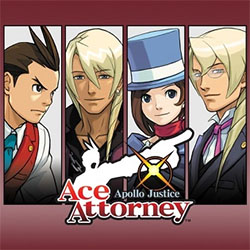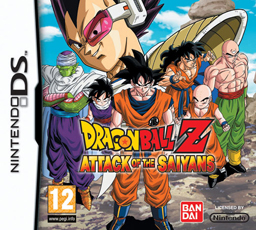
The Mana series, known in Japan as Seiken Densetsu, is a high fantasy action role-playing game series created by Koichi Ishii, with development formerly from Square, and is currently owned by Square Enix. The series began in 1991 as Final Fantasy Adventure, a Game Boy handheld side story to Square's flagship franchise Final Fantasy. The Final Fantasy elements were subsequently dropped starting with the second installment, Secret of Mana, in order to become its own series. It has grown to include games of various genres within the fictional world of Mana, with recurring stories involving a world tree, its associated holy sword, and the fight against forces that would steal their power. Several character designs, creatures, and musical themes reappear frequently.

Baten Kaitos: Eternal Wings and the Lost Ocean is a role-playing video game developed by Monolith Soft and tri-Crescendo and published by Namco for the GameCube. In it, the player assume the role of a "guardian spirit" – an unseen player avatar – who guides protagonist Kalas and his party of companions in an adventure across an aerial floating island-based kingdom in the clouds. The game is focused around the concept of "Magnus" – magical cards that capture the "essence" of items found in the in-game world. The concept is used as a plot device, for in-game item management, and as a basis for the card-themed battle system. The game was noted for its unique battle system, which included aspects of turn-based and action-based battle systems, collectible card games, and poker.
Masato Kato is a Japanese video game artist, scenario writer and director. In the early days of his career, he was credited under the pseudonyms of "Runmaru" and "Runmal". He then joined Square, and was most famous for penning the script of Chrono Trigger, as well as Radical Dreamers, Xenogears, Chrono Cross, Final Fantasy XI and parts of Final Fantasy VII.

Meteos is a 2005 tile-matching video game developed by Q Entertainment and published by Bandai for the Nintendo DS. It was produced by Q Entertainment founder Tetsuya Mizuguchi and designed by Masahiro Sakurai. Meteos was inspired by the video game Missile Command (1980), the film The Matrix (1999) and the television series 24 (2001-2010).

Apollo Justice: Ace Attorney is a visual novel adventure video game developed and published by Capcom. It is the fourth title in the Ace Attorney series, and was released for the Nintendo DS handheld game console in Japan in 2007 and in the West in 2008, for iOS and Android in 2016, and for the Nintendo 3DS in 2017. It was also released for Nintendo Switch, PlayStation 4, Windows and Xbox One in 2024, as part of the Apollo Justice: Ace Attorney Trilogy compilation.
Hanjuku Hero is a Japan-exclusive series of real-time strategy video games. It is directed by Takashi Tokita and published by Square Enix. The series contains four main titles and a spin-off game. The main titles are Hanjuku Hero (1988), Hanjuku Hero: Aa, Sekaiyo Hanjukunare...! (1992), Hanjuku Hero Tai 3D (2003), and Hanjuku Hero 4: 7-Nin no Hanjuku Hero (2005). The spin-off is a Nintendo DS game called Egg Monster Hero (2005), which is a role-playing game with an emphasis on touch-based gameplay. The series is known for its humor and is centered on Lord Almamoon, the protagonist who must save his country from danger in each game.

Bleach: Dark Souls, known in Japan as Bleach DS 2nd Kokui Hirameku Requiem is the second Bleach game for the Nintendo DS. The game introduces new characters, and adds new moves for the older characters as well as introducing new game modes. Bleach: Dark Souls also includes Hollows of varying sizes, for players to fight. The number of Reifu cards in-game are also increased from the original, and more cards are displayed on the touch screen during battle. The Wi-Fi battle mode has been improved to make it easier to play online. The game's theme song is "Resistance" by High and Mighty Color.

Heroes of Mana is a 2007 real-time strategy video game developed by Brownie Brown and Square Enix and published by Square Enix for the Nintendo DS. It is the ninth game of the Mana series and the fourth entry in the World of Mana subseries, following the release of Dawn of Mana three months prior. Set in a high fantasy universe, Heroes of Mana follows a young soldier, Roget, as he journeys to defend several nations from the ruthless aggression of his own country in a series of battles.

Professor Layton and the Curious Village is a puzzle adventure video game for the Nintendo DS system. It was developed and published by Level-5 in Japan and published by Nintendo worldwide. It was released in Japan in 2007 and worldwide the following year. It was re-released in Australia using the British English localisation and European artwork to replace the previously released North American localisation. Curious Village is the first game in the Professor Layton series, followed by Professor Layton and the Diabolical Box. An enhanced mobile port of Curious Village featuring additional cutscenes, subtitled "HD for Mobile", was released in 2018.

Professor Layton and the Diabolical Box, known in Australia and Europe as Professor Layton and Pandora's Box, is the second game in the Professor Layton series by Level-5. It was followed by a third game, Professor Layton and the Unwound Future. The game follows Professor Layton and his self-proclaimed apprentice Luke as they travel cross-country by train to solve the mystery behind a mysterious box that is said to kill anyone who opens it. An enhanced mobile port of Diabolical Box, subtitled "HD for Mobile", was released on December 5, 2018.

Mystery Dungeon: Shiren the Wanderer, originally released in Japan as Fushigi no Dungeon 2: Fūrai no Shiren, is a roguelike video game developed and published by Chunsoft. It is the second entry in the Mystery Dungeon series, following 1993's Torneko no Daibōken. It was originally released for the Super Famicom in 1995 in Japan. Sega published a Nintendo DS remake in 2006 in Japan and in 2008 internationally. The remake was later ported to iOS and Android and published by Spike Chunsoft in 2019.

Final Fantasy Fables: Chocobo's Dungeon is a 2007 role-playing video game published by Square Enix for the Wii. It is an installment in the Chocobo series that focuses on Chocobo and his quest to free a town lost in time from eternal forgetfulness. It is a loose sequel to Chocobo's Dungeon 2 on the PlayStation.

Harvest Moon DS: Sunshine Islands, is a video game that was released on February 21, 2008 in Japan and November 10, 2009 in North America. The seventeenth installment of the Story of Seasons series, and the fourth available for the Nintendo DS, the game closely resembles Harvest Moon DS: Island of Happiness; a section of the island from Harvest Moon: Island of Happiness is one of multiple islands in this game. The player can choose to be a boy (Mark) or a girl (Chelsea).

Soma Bringer is a 2008 action role-playing game developed by Monolith Soft and published by Nintendo for the Nintendo DS. The player, controlling one of the eight main characters, explores dungeons and fights enemies in real-time combat across three-dimensional plains from a top-down perspective. Multiplayer functions allow up to three players to participate in exploration and combat. The story takes place on the continent of Barnea, where its principle magical energy, Soma, is disrupted by the arrival of monsters called Visitors. This prompts a military group called Pharzuph Division 7 to defeat the Visitors and restore the balance of Soma.

Dungeon Explorer: Meiyaku no Tobira and Dungeon Explorer: Jashin no Ryouiki are a pair of action role-playing video game for the PlayStation Portable and Nintendo DS, respectively. Both games were localized and released as Dungeon Explorer: Warriors of Ancient Arts in the United States and as Dungeon Explorer in Europe. The games are related to the PC Engine game Dungeon Explorer. Both are action role-playing games. They feature wireless connectivity to allow multiple players to connect to each other, and Jashin no Ryouiki also allows for online play using Nintendo Wi-Fi Connection on the Nintendo DS.

Sands of Destruction is a role-playing video game developed by Imageepoch and published by Sega for the Nintendo DS. It was released in Japan in 2008, and in North America in 2010. The story revolves around a young man, Kyrie, who possesses the power to destroy the world, though he does not know why. The female lead is Morte, a member of a group that is trying to destroy the world.

Dragon Ball Z: Attack of the Saiyans, known in Japan as Dragon Ball Kai: Saiyan Invasion, is a video game based on the Dragon Ball franchise for the Nintendo DS. It was released in Japan on April 29, 2009, and in Europe and North America in November 2009. The game is developed by Monolith Soft and distributed by Namco Bandai in North America ; it is one of the first games in the Dragon Ball franchise to be published by Namco Bandai, as the company would acquire the license from previous holder Atari in July of the same year.

Professor Layton and the Last Specter, known in Europe as Professor Layton and the Spectre's Call, is a puzzle adventure video game produced by Level-5 for the Nintendo DS handheld game console. Last Specter is the fourth game in the Professor Layton series, and is a prequel that takes place three years before the first trilogy, detailing how Professor Layton met his apprentice, Luke Triton and introducing Layton's assistant Emmy Altava.

999: Nine Hours, Nine Persons, Nine Doors is a visual novel and adventure video game developed by Chunsoft. It is the first installment in the Zero Escape series, and was released in Japan in December 2009 and in North America in November 2010 for the Nintendo DS. The story follows Junpei, a college student who is abducted along with eight other people and forced to play the "Nonary Game", which puts its participants in a life-or-death situation, to escape from a sinking cruise liner. The gameplay alternates between two types of sections: Escape sections, where the player completes puzzles in escape-the-room scenarios; and Novel sections, where the player reads the game's narrative and makes decisions that influence the story toward one of six different endings.

Final Fantasy III is a Nintendo DS role-playing video game and a remake of the 1990 Family Computer game, Final Fantasy III.


















